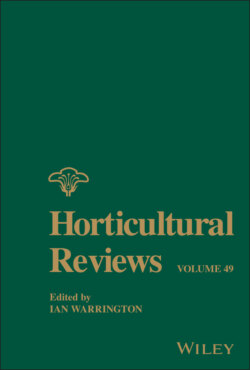Читать книгу Horticultural Reviews, Volume 49 - Группа авторов - Страница 19
VI. BIOTIC AND ABIOTIC CONSIDERATIONS
ОглавлениеOakleaf hydrangea has the unique ability to flower in dense shade as well as tolerate full sun. The capacity to flower even in deep shade sets it apart from most other flowering shrubs (Dirr 2004). Nevertheless, blooming improves with sunlight, as does flower color on genotypes which become pink with age. Similarly, fall foliage color is also enhanced on sun grown plants. However, if planted in prolonged direct sunlight in hot climates, the leaves have a tendency to wilt and desiccate. Oakleaf hydrangea are more sun tolerant in landscapes located in cooler climates, although flowering may be less impressive under such conditions (Lawson‐Hall and Rothera 1995). In the wild, H. quercifolia tends to occur in shady forest understories and is rarely found in daylong full sun situations.
Like most hydrangeas, H. quercifolia requires moist but well drained soil and will wilt in hot periods of the day when moisture is limiting; even when adequately watered, plants may still wilt when under extremely high temperatures unless protected from direct sun. Oakleaf hydrangea is susceptible to several root rot diseases, particularly in wet soil (discussed below), so care must be taken not to irrigate too frequently. Indeed, wild H. quercifolia most frequently occurs in well‐drained substrates such as cliff faces, steep ravines, and rocky outcrops (Figure 1.4).
Limited information is available regarding cold hardiness in Hydrangea quercifolia. Dirr et al. (1993) used controlled freezing tests on ‘Alice’ and ‘Alison’ to determine cold hardiness and found the maximum hardiness was achieved in December with both accessions surviving –27°C (which corresponds to USDA cold hardiness zone 5a). ‘Alice’ maintained cold hardiness longer into spring than ‘Alison’, suggesting that it may resist deacclimation longer, and therefore tolerate late freezes better. Additionally, this may indicate that genotypic variability for both cold hardiness and deacclimation exists within the species. The full range of variation in midwinter cold tolerance for the species and a subset of cultivars is currently being explored by the University of Minnesota Woody Landscape Plant Breeding and Genetics program. Preliminary results indicate a wide range of variation for deacclimation timing (Sherwood et al. 2021).
H. quercifolia is susceptible to several vascular pathogens. Phytophthora nicotiana Breda de Haan, Pythium spp., and Rhizoctonia solani Kühn are fungal pathogens that infect the vasculature of oakleaf hydrangea through the roots and cause wilt disease. While no genetic resistance has been reported to exist against these various root rot pathogens, cultural practices can be employed to minimize disease pressure. Avoiding frequent irrigation and using a freely draining medium for container‐grown plants can reduce the severity of infections (Baysal‐Gurel et al. 2016b). Armillaria mellea Kumm. and A. tabescens Emel are also vascular wilt fungi that can infect oakleaf hydrangea and are especially problematic with in‐ground plantings. One possible source of Armillaria is wood mulch infected with the fungus, and therefore care should be used when using such mulching.
Many foliar pathogens have been reported to infect hydrangeas, including Cercospora hydrangeae Atk., Corynespora cassiicola Wei, Phoma exigua Sacc., Glomerella spp., Myrothecium roridum Sacc., Alternaria alternata Keissl., Xanthomonas campestris L., and Botrytis cinerea Pers. (Hagan et al. 2004; Mmbaga et al. 2012; Mmbaga et al. 2015). Among these, Ce. hydrangeae and Co. cassiicola are the most frequently occurring on infected H. macrophylla leaves (Mmbaga et al. 2012). The fungus Ce. hydrangeae and the bacteria X. campestris have been identified on oakleaf hydrangea with foliar leafspot symptoms (Hagan and Mullen 2001; Mmbaga and Oliver 2007; A. Sherwood unpubl.). Leafspots caused by X. campestris on oakleaf hydrangea are typically brown, angular lesions that are contained by the leaf veins (Figure 1.7). Because dead leaves are a source of inoculum, removing fallen leaves and avoiding overhead irrigation are effective control strategies (Baysal‐Gurel et al. 2016a). Further, Mmbaga and Oliver (2007) have shown a kaolin powder based natural pesticide to be as effective in protecting H. quercifolia from X. campestris infection as the broad‐spectrum fungicides that were also tested. Powdery mildew (Golovinomyces orontii syn. Erysiphe polygoni) is a common foliar disease on H. macrophylla, but H. quercifolia seems to be relatively more resistant (Baysal‐Gurel et al. 2016a); this difference may be due to the pubescent leaf surfaces of H. quercifolia in comparison to the glabrous leaves of H. macrophylla.
Oakleaf hydrangea does not have any particular insect pest issues, however generalist nursery and landscape pest insects will sometimes feed on H. quercifolia. Japanese beetle (Popillia japonica Newman) has been noted to be the most abundant insect feeding on H. quercifolia in our studies at the University of Minnesota (A. Sherwood, unpubl.). Mmbaga and Oliver (2007) demonstrated that kaolin powder is as effective at controlling Japanese beetle feeding on H. quercifolia as a broad‐spectrum insecticide. This would be an option for use in nursery or greenhouse settings when additional pest defense is needed. However, kaolin powder may not be suitable for landscape use considering the unsightly appearance of the leaves after application.
Figure 1.7 Photograph showing range of bacterial leafspot (Xanthomonas campestris) severity in oakleaf hydrangea.
(Source: Photo credit: A. Sherwood.)
